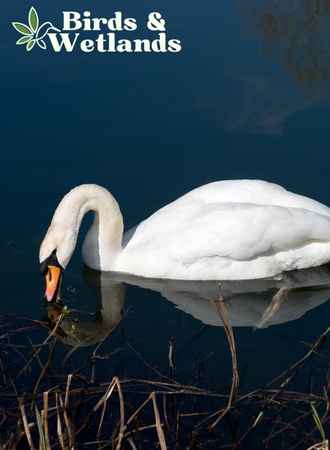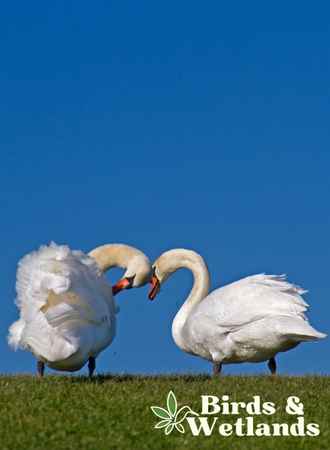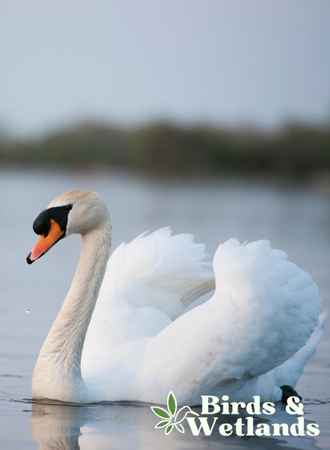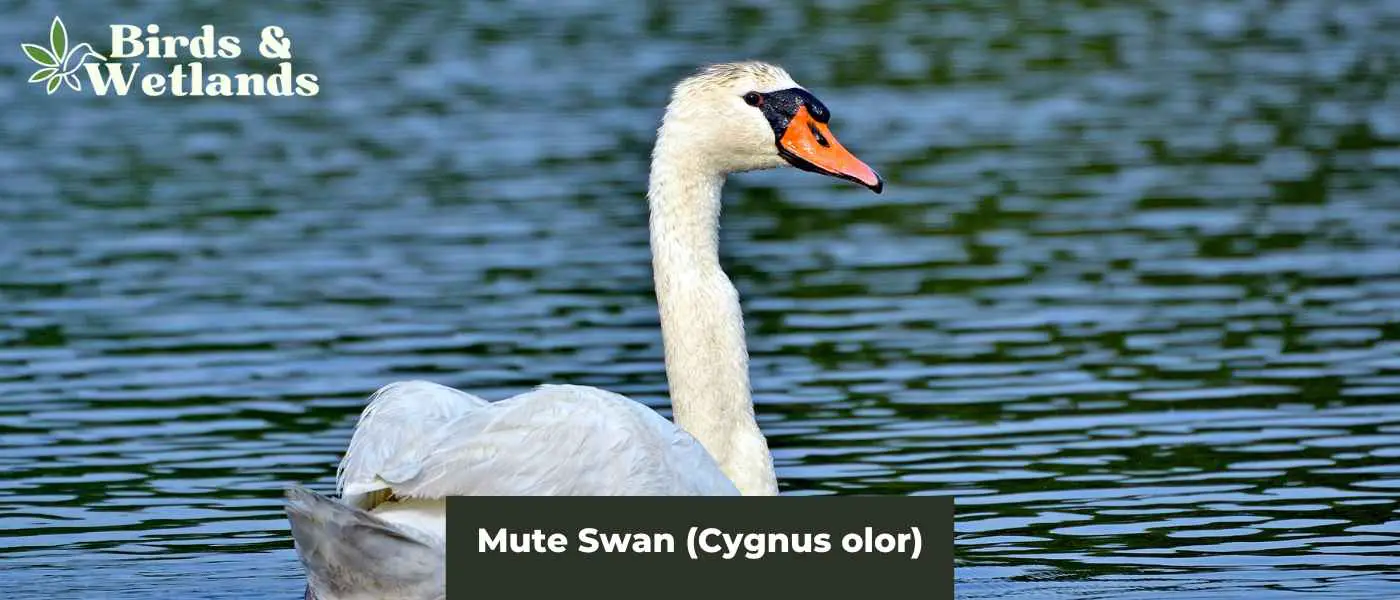The mute swan, also known as Cygnus olor, is a large water bird that belongs to the family Anatidae. This species is scientifically classified as part of the order Anseriformes, which includes all types of waterfowl, such as ducks, geese, and swans. It is a closest relatives are the black swans of Australia and the black-necked swan of South America.
Mute swans are native to Europe and Asia, primarily found in and around freshwater lakes, marshes, and rivers. However, they have also been introduced to other parts of the world, such as North America, Australia, and New Zealand, where they were originally brought to adorn large estates and zoological gardens.
Mute swans have thrived and established populations in these places. In some areas, they are considered invasive due to their large numbers and tendency to displace native birds.
The common name “mute swan” comes from the bird’s relatively quiet nature. Unlike other swan species, mute swans do not have a loud vocalization, which led to the name “mute.” The most familiar sound they make is a vibrant throbbing of their wings while in flight, snorting noises and hoarse whistling.

Mute Swan Description
The mute swan has white feathers with possible faint brownish tinges on its crown, cheeks and neck.
The male mute swan has a black knob at the top of its bill, which is orange with a black nail. Its eyes are dark brown, and it has black lores. It also has short, strong black legs and webbed feet.
The female mute swan has similar plumage and appearance as the male, but she tends to be slightly smaller. The knob on her bill is also smaller than the male’s.
The mute swan’s long slender neck gives it an elegant appearance when swimming.
When threatened, mute swans stretch out their wings to appear larger and intimidate predators or rivals. They have six primaries on each wing, allowing for powerful flight and the ability to migrate long distances depending on location and climate conditions.
Young mute swans, also called cygnets, have a unique plumage, a greyish-brown color which is a genetic trait before they gain their white adult plumage during the first winter. However, some feathers may remain grey until the second year of life.
The legs are dull greyish-black, and its bill is typically dark gray. They have long necks and their eyes are brown in hue throughout their youth, giving them a beautiful appearance. White cygnets will retain its white plumage.
The Polish swan is a mute swan with a distinct coloration. Its legs are pinkish instead of dark gray.
Listen to the Mute Swan
Mute Swan Habitat
The mute swan is a water bird and prefers to live in large shallow waters such as small lakes, ponds, marshes, coastal lagoons and estuaries. It will take advantage of sheltered bays and coastal waters during winter.
However, the mute swan has adapted to human activity and can be found in artificial lakes and ponds, such as parks or private properties.
In terms of shelter and nesting sites, mute swans enjoy being near islands or low-lying sandbanks where they can easily spot approaching predators from a distance. These birds also require calm waters without shallow or strong currents that may interrupt their path or make it difficult to hunt for food.
Moreover, some mute swans migrate away from colder climates during the winter in search of warmer environments that offer more abundant food sources and less competition for resources with other birds living in their native range.

Mute Swan Population Range & Distribution
The mute swan is native species to temperate regions of Europe and the Palearctic. These birds breed in North Central Asia, north-central Europe and the British Isles (southern England and southern tip of Öland Island). Some birds may travel to western Europe and North Africa in the winter.
The mute swan has also been introduced to North America, East Asia, and Oceania.
In North America, the mute swan inhabits the Atlantic coast and inland areas of Canada, Alaska, Pacific Northwest, Great Lakes and California. It has also been introduced to parts of Mexico and Central America. It is rare in the far north.
Mute Swan Diet
Mute swans have a diverse diet, including leafy parts of aquatic plants, grains, grasses, small amphibians, mollusks, worms, insects, algae, fish eggs, crustaceans and snails. They use their bill to catch prey and filter out mud using their lamellae. They forage in shallow water, wet meadows and grassy areas for food.
In addition to natural food sources, they consume grains and small amounts of corn, providing extra energy for long journeys or cold winter days.
During the winter, when food is scarce, they may rely on artificial food sources provided by people in city parks or other urban areas.
Young mute swans rely heavily on insects during their growth period because they provide a balanced nutritional intake high in protein. Adults may also supplement their diet with small fruits and berries depending on availability in different seasons and locations.
The mute swan dabbles food from the water’s surface. It may also submerge its head and long neck to pull plants and eat small animals.

Mute Swan Behavior, Nesting & Mating Habits
Mute swans are typically monogamous, forming a pair bond with a single mate for the breeding season. However, if a mate dies or is unavailable, they seek a new mate.
In North America, the breeding season for mute swans typically begins in late March or early April and can last until June. This can vary depending on the specific location and climate.
Mute swans typically build their nests on the banks of freshwater ponds, rivers, or lakes. They prefer to build their nests in areas with plenty of vegetation, such as reeds or tall grass, for camouflage and protection.
Both the male and female will participate in building the nest in their nesting area, which is usually a large pile of plant material, such as sticks, reeds, and grasses, lined with down feathers. The nest can be large, sometimes up to 6 feet in diameter.
Female mute swans typically lay 3 to 8 eggs per clutch, averaging 5. The female incubates the eggs for about 36 to 42 days, while the male guards the nest and brings food to the female. Both parents will take turns incubating the eggs, with the female doing most of the incubation during the day and the male taking over at night.
Yes, baby swans, also known as cygnets, are precocial at hatching, meaning they are relatively mature and mobile from birth. They are covered in down and can move around independently within a few hours of hatching.
The parents will continue to care for the young birds, providing food and protection. The cygnets will fledge or learn to fly when they are about 2 to 3 months old. However, they will continue to depend on their parents for food and protection for several months after fledging.
Mute swans are known for their aggressive behavior towards other wildlife. The posture, characterized by a curved back and partially raised wings, commonly referred to as “busking,” is actually a form of aggressive threat display if the mute swan is threatened by other swans and animals.

Mute Swan Conservation Status
The conservation status of the mute swan is a subject of some debate. In North America, the mute swan is considered an invasive species and its population is managed to prevent it from competing with native wildlife species for resources. They have caused ecological destruction in the Chesapeake bay region of Maryland.
Some states in the US have even made it legal to hunt them. However, the mute swan is considered a protected species in other parts of the world, such as Europe but this status has not prevented illegal hunting. In the 1960’s, their numbers declined significantly due to lead poisoning but has since recovered, thanks to better protection.
It’s important to note that the mute swan is a non-native bird species in North America. Its population has grown significantly in recent decades, which has led to concerns about the potential impacts on other species of native waterfowl and aquatic ecosystems. And management plans are put in place to prevent potential negative impacts on native wildlife.

Key Takeaways
- The mute swan has white plumage and a pronounced knob atop an orange bill.
- Mute swans are native to temperate areas of Europe and Asia, primarily found in and around freshwater lakes, marshes, and rivers.
- Mute swans are relatively quiet and do not have a loud vocalization, which led to the name “mute.”
- The mute swan has been introduced to North America, East Asia, and Oceania.
- Mute swans have a diverse diet, including submerged aquatic vegetation and small animals.


